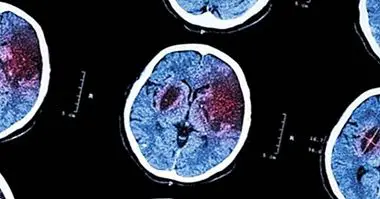Autocannibalism (disease): causes, symptoms and treatment
Possibly most people know someone who bites their nails. They often do so in situations of nervousness or stress, as a way to relax and reduce tension. Other people tear themselves, chew and even eat their own hair.
Others self-harm. Although it is not a frequent phenomenon, sometimes cases have been detected of individuals who for various reasons, who may or may not pass through the reduction of anxiety, decide to attack and consume parts of their own flesh producing injuries of varying importance. We are talking about autocanibalism .
Cannibalism and autocannibalism
It is called cannibalism to the act or practice of consuming and feeding members of the same species . This practice has been observed in nature in various species, usually in the absence of prolonged absence of other food or as a method of population control.
In the human being cases of cannibalism have also been seen throughout history. In many cases these practices have also been derived from the lack of food. It is known for example that during the epidemic of black plague that ravaged Europe during the Middle Ages many tombs were looted in order to consume the flesh of the deceased. On other occasions these practices are linked to religious rituals, as in different African and South American tribes.
Some drugs or psychotic episodes can provoke an aggression that culminates in an attempt to feed on the opponent. There have also been cases in which acts of cannibalism have been derived from paraphilias of the sadistic type, in some cases accepted by the victims and even devouring their own organs.
By last it has been intentionally used as a way to terrorize and morally destroy a target population , both at the idea of being consumed and being forced to consume human flesh.
Feeding on one's own flesh
Thus, as mentioned, cannibalism refers to the consumption of meat from individuals belonging to the species of belonging itself. However, there are cases in which the cannibal act is directed towards the person who makes the consumption.
Self-cannibalism differs from the practice of cannibalism in that, as a general rule, the goal of behavior is not usually aimed at the consumption of human flesh, but rather tends to be linked to an attempt to reduce anxiety and internal tension of those who carry it out or else temporarily free from feelings of self-rejection or emotional suffering. The autocanibalismo does not appear registered as a disorder by itself, being rather the result or the manifestation of some type of problem.
In what contexts does autocanibalism appear?
Like other types of self-injurious behavior, This type of behavior is usually linked to the presence of severe cognitive and perceptual alterations . The subjects who practice them tend to have alterations of consciousness or a diminished cognitive capacity.
Some of the cases detected are usually linked to severe cases of disorders that involve a deterioration of cognitive ability and of one's own consciousness. In situations that produce a high level of activation, agitation and impulsiveness, there are occasional self-injurious behaviors (including autocannibalism in the form of self-injuries), usually as a mechanism to control anguish and internal tension.
Occasionally it occurs in individuals with intellectual disabilities, some severe cases of neurodevelopmental disorders (self-harm has occurred in some cases of autism). Also, autocannibalism can occur during psychotic outbreaks or in people suffering from intoxication by psychodysleptic substances (hallucinogenic, for example) or psychoanalytic (exciting).
These behaviors have also been observed as a method of reassurance in some withdrawal syndromes . There have even been cases in some personality disorders, such as borderline personality.
Finally, this type of behavior has been observed in some subjects that link self-harm and consumption of their own organism to sexual pleasure, deriving from sadomasochistic paraphilias. An example of this is found in the case of the cannibal of Rottenburg, whose victim agreed to eat parts of his body before being devoured.
Lesch-Nyhan syndrome
Besides appearing in situations and disorders such as those mentioned above, there is a medical syndrome in which the acts of autocannibalism are relatively frequent, which has earned it the popular name of the autocanibalism disease. It is the Lesch-Nyhan syndrome.
This disorder of genetic origin, linked to a defect in a recessive gene of the X chromosome, causes the hypoxanthine-guanine-phosphoribosyl-transferase enzyme. It tends to cause a hyperproduction of uric acid, dysfunctions at the neurological level that usually cause intellectual disability and behavior alterations.
Within these behavioral alterations, the presence of constant self-harm stands out, among them acts of self-cannibalism centered on the bite of the parts of the body that can reach, especially fingers and lips. It appears only in males, although women can be carriers and transmit it to their offspring.
Possible treatments
Considering that it is a symptom rather than a disorder itself, the treatment of autocannibalism will often be linked to the type of problem that causes it . It is necessary to take into account the reason for the self-injury and the degree of awareness of the individual who makes it at the time of doing it.
At the psychological level, the use of different behavior modification techniques may be useful. One of the techniques used for the treatment of self-injurious behaviors such as autocannibalism is the behavioral dialectic therapy, through which we seek to make a modification of the behavior while trying to change the type of relationship with the subject. the condition that causes this type of behavior.
Other types of therapies such as conditioning in the form of reinforcement by emission of incompatible behaviors could be helpful in order to vary the type of behavior in cases in which autocannibalism is a response to anxiety situations.
If the autocanibal act is given for sexual reasons it may be indicated to use focused techniques to redirect the desire towards another type of stimulation and decrease the attractiveness of the autocanibal behavior . Although it is not a generally recommended type of treatment, in very serious cases, aversive techniques of a chemical nature may be applied, causing a rejection in the subject of self-harm and trying to consume his own flesh.
If, for example, the autocanibal practice is derived from the consumption of substances or from a psychotic outbreak, the treatment must be directed in the first place to control the outbreak or intoxication in question and reduce its symptoms.



















